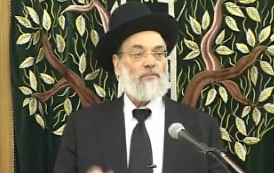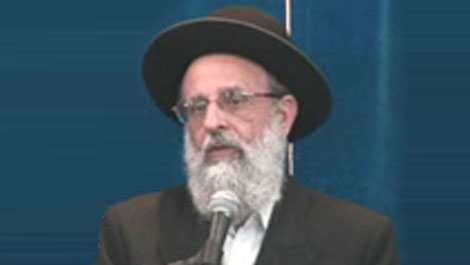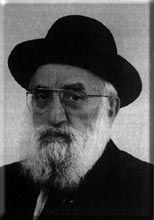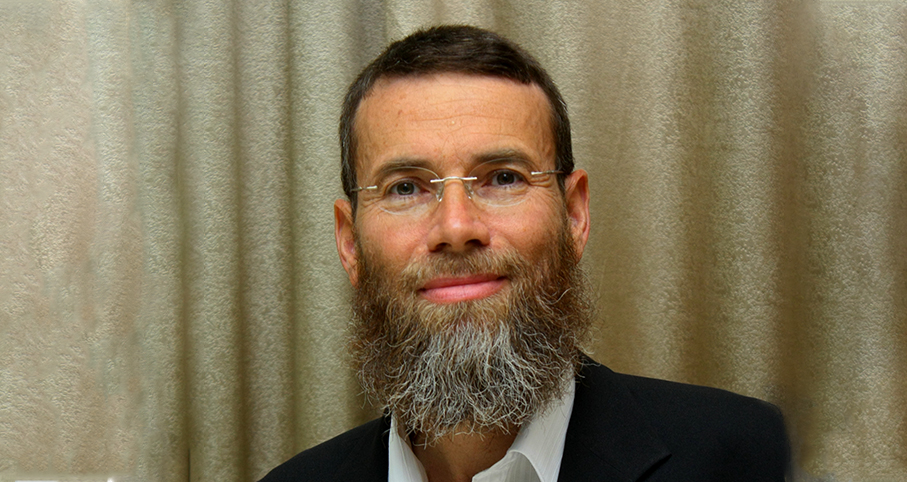Beit Midrash
- Torah Portion and Tanach
- Shmot
- Va'era
With the falling of the ghetto walls that had kept the Jews in central Europe isolated from the world around them, many Jews began to assimilate into the surrounding environment and distance themselves from Judaism. Although it was far more difficult for Jews in Eastern Europe to assimilate fully into non-Jewish society, different forces, the haskalah, socialism, Communism and various other movements similarly severed many Jews from keeping mitzvos. Among those who abandoned Torah observance were Jews who felt that Chazal’s interpretation of the mitzvos was not based on the Written Torah.
In response, several new and original commentaries on Chumash appeared. Among them, we find Hakesav Vehakabalah, by Rav Yaakov Tzvi Mecklenburg, the commentaries 1 of the Malbim to Tanach, the commentary of Rav Samson Raphael Hirsch, and the Ha’ameik Davar, the commentary of Rav Naftali Tzvi Yehudah Berlin (also known as the Netziv). All four of these commentaries, although very different from each other in important ways, were written to explain the Written Torah in the spirit of Chazal.
Hakesav Vehakabalah
Rav Yaakov Tzvi Mecklenburg was a disciple of Rabbi Akiva Eiger and served as the rav of Koenigsberg, Prussia (today, Kaliningrad, Russia), for thirty-four years. Koenigsberg was in the far east of Germany, giving Rav Mecklenburg a clear view of the challenges posed by the rise of the Reform movement in Germany and the haskalah and other anti-religious movements in Eastern Europe. Hakesav Vehakabalah, first published in 1839 and followed by three more editions in the author’s lifetime, was intended as a response to attacks on Chazal’s understanding of the Torah.
Hakesav Vehakabalah carefully analyzes the root meanings and grammar of the words of the Chumash, using them to provide a clear interpretation of the pesukim. Although his approach is highly original, he also often cites the different approaches of the earlier commentaries, opting for the one that he demonstrates to be the most accurate.
The Malbim
Rav Meir Leibush ben Yechiel Michel, known by his acronym, Malbim, served as the rav of many different Eastern European communities. A brilliant talmid chacham and a warrior against the haskalah, his magnum opus is his commentary to Tanach and accompanying essays. 2 His first work, a commentary on Yeshayah, includes an introduction in which he elucidates the principles that form the basis for his commentary to Tanach as a whole.
Two such principles are that no two words in Tanachic Hebrew have precisely the same meaning, and that there are no repeated phrases or clauses -- each word in Tanach was chosen to provide a very specific nuance of meaning.
Rav Samson Raphael Hirsch
Rav Samson Raphael Hirsch held rabbinic positions in Oldenberg and Emden, Germany, and as Chief Rabbi of Moravia, before returning to Germany to establish a modern, Torah-committed community in Frankfurt. Toward the end of his life, he produced his commentaries to the Chumash, Tehillim and the Siddur.
The Netziv
Rav Naftali Tzvi Yehudah Berlin married the daughter of Rav Yitzchak of Volozhin, the son and successor of the founder and Rosh Yeshivah of the famed yeshivah in that city, Rav Chayim of Volozhin, the esteemed disciple of the Vilna Gaon. The Netziv eventually became Rosh Yeshivah of the yeshivah in Volozhin, a position he held for almost forty years, until its closing in 1892. The Netziv authored many works, including responsa and commentaries on Chumash, Shas, the She’iltos of Rav Achai Gaon, the halachic midrashim.
Linking Torah shebiksav to Torah shebe’al peh
Both Hakesav Vehakabalah and Malbim write that a major purpose of their commentaries is to demonstrate the unity of Torah shebiksav and Torah shebe’al peh. In the introduction to the first volume of commentary he wrote on Chumash, Vayikra, the Malbim mentions specifically the tragedy of the Reform convention that had taken place in 1844 in Braunschweig (called Brunswick in English), a city in Germany about 40 miles southeast of Hanover. The Malbim writes that when he heard of the disgraceful attitude toward Torah that had been demonstrated there, he realized that klal Yisroel required a new commentary on Tanach, written according to the mesorah. He notes many rules that he will be following in his commentaries, one of which is to show the unity of Torah shebiksav and Torah shebe’al peh.
Although Rav Hirsch’s very brief introduction to his commentary does not emphasize this relationship between Torah shebiksav and Torah shebe’al peh, this foundation shows up literally hundreds of times in his commentary. 3 Rav Hirsch, too, maintained that proper study of Torah shebiksav leads directly to the conclusions of Torah shebe’al peh. Among examples where he demonstrates this are when he explains that Chazal’s understanding of "an eye for an eye" as financial remuneration (Shemos 21:24) is indeed the only proper way to understand the pasuk, and that no halachic requirement exists to name the firstborn child of a levirate marriage (yibum) for the deceased brother (see Devorim 25:6).
Rav Hirsch noted that the Torah shebe’al peh was actually taught to the Jews first. 4 Moshe received all the laws of Torah shebe’al peh at Har Sinai and taught them to the Jewish people gradually. The completed Torah shebiksav, by contrast, was not received by the Jews until the very end of Moshe’s life, immediately prior to the Jews' entering Eretz Yisroel, or forty years after they had received the Torah shebe’al peh. This explains numerous passages in the Torah, including the commandment to slaughter animals ka’asher tzivisicha "as you were instructed," meaning the sets of regulations that had been transmitted to Moshe at Har Sinai and previously taught to the Bnei Yisroel.
Uniqueness of Rav Hirsch’s commentary
The most obvious difference between Rav Hirsch’s commentary and the others is the language in which it was written. Whereas the other commentaries are written in traditional rabbinic Hebrew, Rav Hirsch published his commentary on Chumash and, indeed, all of his works, in German. Long before Rav Hirsch’s time, many Torah works had been authored in the vernacular, such as all of Rav Saadiya Gaon’s writings and those of the Rambam, with the exception of the Mishneh Torah.
Yet, sefarim in the vernacular had fallen into disuse in the hundreds of years since the era of the rishonim. As a young rabbi in Oldenberg, however, Rav Hirsch recognized the need to present Torah teachings in German, in order to reach his generation and impress upon them Torah’s eternal relevance.
In Rav Hirsch’s commentary, there are various instances in which he includes a comment in Hebrew. Invariably, these are the comments of a Torah scholar on a point in Talmudic discussion which was not appropriate to make for the general audience for whom his work was intended. Yet, he was concerned that posterity not lose the important halachic point he had realized. To accommodate this, he chose to write these points in scholarly, rabbinic Hebrew.
Aside from his use of the vernacular, there are many other novel features in Rav Hirsch’s approach. Beyond being an interpretation of Chumash, Rav Hirsch uses his commentary to demonstrate how to use the Torah as the primary educational tool for man to grow as a human being. There is virtually not a comment of his on the Torah that does not provide a moral lesson, or musar haskeil.
Indeed, there are many occasions when he did not comment upon questions about pshat in a verse where it would appear appropriate for him to have done so. Clearly, he refrained from providing commentary where the conclusion would not provide any lesson one can utilize for personal growth.
Rav Hirsch called his Torah hashkafah by the term Torah im Derech Eretz, the details of which he developed in different places in his commentary. 5 Although the expression is often misunderstood, Rav Hirsch used it to mean that Torah and its observance must always be the primary focus of a Jew’s life, and that this can and must pervade a Jew’s behavior in all places, times and situations. Everything else that this world has to offer, including livelihood, education, culture, and social mores, must be subsumed within a Torah framework.
Reasons for mitzvos
One of Rav Hirsch’s great innovations is his explanation of the ta’amei hamitzvos. The Sefer Hachinuch explains that the term ta’amei hamitzvah means the taste of a mitzvah, not its reason, and it is this taste that Rav Hirsch sought to provide.
The concept of deriving educational reasons for mitzvos was certainly not originated by Rav Hirsch. Rav Hirsch himself quotes dozens of places where Chazal discuss what lesson one can derive from the observance of the mitzvos, and rishonim like the Rambam in his Moreh Nevuchim, Ramban in his commentary on the Torah, and the Sefer Hachinuch devote much space to this study.
However, Rav Hirsch added several dimensions to the concept of ta’amei hamitzvah. For Rav Hirsch, an explanation of a mitzvah must always fit in with every detail of the halachos of that mitzvah. For this reason, Rav Hirsch first develops and explains all the halachic details of the mitzvah and then weaves an explanation for the mitzvah that comports with all those details. At times, this required him to first resolve halachic details regarding the laws of the mitzvah.
Here is an example in which we see the difference between the approach of Rav Hirsch and that of his predecessors. The Ramban explains that the reason for the mitzvah not to mix meat and milk together is because cooking a newly slaughtered kid in the milk of its mother will create cruelty in the person who does this. 6 However, this reason for the mitzvah has little to do with the halachos of this mitzvah, which prohibit any meat and any milk of two kosher species cooked together.
Rav Hirsch, on the other hand, first explains the laws of the mitzvah, and then demonstrates why the Torah’s description of cooking a goat in the milk of its mother is the simplest way to express these ideas. He subsequently proceeds to explain a philosophic reason for the mitzvah that we can appreciate and that can teach us a moral lesson, while observing the mitzvah. In this instance, Rav Hirsch provides a brilliant and extensive seven-page essay presenting why this prohibition is limited to the meat and the milk of kosher, domesticated animal species, and why it includes not only the consumption, but also the cooking of and benefit from this mixture. 7
Here is another example. The Torah forbids planting any trees near the mizbei’ach. 8 As an explanation of this mitzvah, the Ramban explains that even though one is planting a shade tree that will enhance the area of the Beis Hamikdash, this is still prohibited, since it was the custom of the idol worshippers to plant trees near the entrance to their temples.
Rav Hirsch is not satisfied with approaches like this to explain mitzvos. Instead he notes that the thriving of a tree near an idol was considered a sign of the influence of the god. This idea fits very appropriately to the heathen notion that gods are primarily forces of nature, whose rule manifests itself in the phenomena of the physical world. However, such notions are diametrically opposite to the Jewish concept of G-d. A Jew is obligated to subordinate all his aspirations, including his moral and spiritual world, to the sphere of G-d’s sovereignty. Only through this can he expect to succeed in the physical world. 9
Frequently, Rav Hirsch presents highly original approaches to ta’amei hamitzvos, such as his explanations for the mitzvos of arayos, keifel, arachin, and tum’ah and taharah, and the disqualification of blemished animals and blemished kohanim from the service of korbanos. Regarding tum’ah, for example, he notes that the foundation of most religions is the fear of death, and it is at this time that the priest assumes his greatest role. The Torah, in contrast, bans the kohen from being involved with the dead, to demonstrate that the Torah’s goal is that we grow and develop throughout life – when we are in our best health. To emphasize this, the kohen, whose role is to educate how to live as a Jew, is distanced from death.
Rav Hirsch uses the same concept to explain why a kohen with a physical blemish or injury is forbidden to serve in the Beis Hamikdash and why a similarly impaired animal is prohibited as a korban. This emphasis on physical beauty or selectivity seems to run counter to the Torah’s idea of equal access for all to a relationship with Hashem.
Rav Hirsch explains that religions generally become the home of the marginalized and alienated in society. By prohibiting the physically impaired from performing the service in the holiest of places, the Torah emphasizes that its goal is to foster in all Jews the development of a relationship with Hashem, rather than to simply provide a refuge for the disenfranchised.
We will continue with this topic next week.
This Shiur is published also at Rabbi Kaganof's site
^ 1.I refer to the commentaries of the Malbim because, although he wrote on almost the entire Tanach, a rare accomplishment, his treatment of different parts of Tanach is so varied as to make it difficult to refer to it as one commentary.
^ 2.On Chumash, the Malbim follows two different styles. As I mention in the article, his commentary on Vayikra and parts of Devorim is an explanation of the midrashei halachah, the Sifra and the Sifrei, in which he delves into Chazal’s method of understanding Torah Shebiskav. On the other hand, his commentaries to other parts of Chumash bear close similarity to the commentary of the Abarbanel, which, as he says himself, he used. He presents many questions on the topic at hand, and then weaves an explanation to answer them. Yet another style is presented in his commentaries to Esther and Shir Hashirim, in which he presents his own midrashic-style approach to these works.
^ 3.This point is the main thrust of Dayan Isaac Grunfeld’s introduction to Rav Hirsch’s commentary, which I will quote in the sequel of this article.
^ 4.Commentary of Rav Hirsch to Bereishis 1:19.
^ 5.See, for example, commentary of Rav Hirsch to Vayikra 18:4.
^ 6. Ramban, Devorim 14:21.
^ 7.Commentary of Rav Hirsch to Shemos 23:19.
^ 8.Devorim 16:21.
^ 9.Commentary of Rav Hirsch to Devorim 16:21. Based on the Haberman translation .

Parashat Hashavua: “With a Strong Hand He Will Expel Them from His Land
Harav Shaul Yisraeli – from Siach Shaul, p. 205-6
Rabbi Yossef Carmel | Tevet 5785

Freewill: Use It or Lose It
Rabbi Jonathan Sacks | Tevet 1 5778

Miracles and Magic in Parshat VaEra
Rabbi David Dov Levanon | 5763























